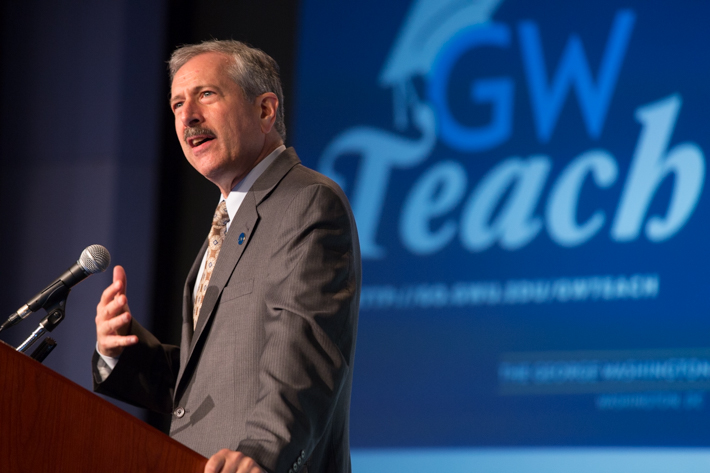In the fight to produce more qualified science, technology, engineering and mathematics (STEM) graduates in the United States, there is one crucial weapon: teachers.
George Washington University Provost Steven Lerman is a civil engineer by training and background, and credits some of his passion for that field to two math and science teachers he had in middle school and high school. “They were energetic, they were open to inquiry,” he said. “They were patient and encouraging.”
Dr. Lerman was speaking at the Tuesday afternoon launch event for GWTeach, a program that will help produce more teachers qualified to teach STEM subjects—and that may be part of the solution to the floundering state of STEM education in the United States.
GWTeach—modeled on UTeach, an initiative founded at the University of Texas-Austin—will train undergraduate STEM majors to be public school math and science teachers. With the help of a curriculum grounded in both their major subjects and in teaching, graduates will be double threats, acquiring both a degree in their chosen field and certification to teach in the Washington, D.C., public schools.
One of 44 institutions around the United States to replicate the UTeach Austin initiative, the program was brought to GW by a $22.5 million grant from the Howard Hughes Medical Institute to the National Math and Science Initiative (NMSI). The grant funded UTeach partnership to 10 research universities, GW—which received a $1.45 million grant to implement the program—among them.
“All of us know that our STEM pipeline is in critical need of repair,” said Ben Vinson, dean of the Columbian College of Arts and Sciences. “Through this partnership, we now have a clearer vision, a roadmap, for how to address the challenges ahead and how to be part of the solution.”
Kim Cherry, deputy chief of STEM for the District of Columbia Public Schools, glowed as she described the potential of the program for the students she serves. “This is about giving an opportunity to urban students who would not otherwise have the chance to excel in math and science,” she said.
GWTeach is aimed, at least in part, at students who may not realize they have a passion for teaching. Introductory classes in the UTeach curriculum are open to all students and require no commitment. But one of the most impressive features of UTeach is its retention rate: Ninety percent of UTeach Austin graduates enter the teaching profession, and five years after graduating, 80 percent are still in schools.
“When students have the option to pursue that interest [in teaching], it expands and doesn’t limit their opportunities,” said Mary Walker, associate director of the UTeach Institute. “It gives them two career options—though they generally go on to fall in love with teaching and to choose that.”
Jerry Feldman agreed. The undergraduate program director for physics at CCAS, Dr. Feldman is co-director for science in GWTeach. He emphasized that the skills needed to be a good secondary school teacher are applicable to careers across the STEM spectrum and beyond.
“[Students] will enhance their own content knowledge—they’ll learn their discipline much better, because as they say, you never really learn something until you have to teach it to someone else,” he said. “They will greatly enhance their communication skills. And as teachers, they’ll learn to listen, to lead students to their own construction of comprehension. These are valuable life skills in general.”
“We’re going to be making a significant contribution to the steady and continuous flow of well-qualified science and mathematics teachers for the public schools,” said Graduate School of Education and Human Development Dean Michael Feuer.
And that contribution, Dr. Vinson said, is key to the United States’ future as “a STEM-proficient workforce and citizenry.”
“My hope is that this will inspire a renewed passion in math and science that will follow students not only in the classroom, but also to the boardroom, the think tank, the halls of government—whatever career path our students choose,” he said.


